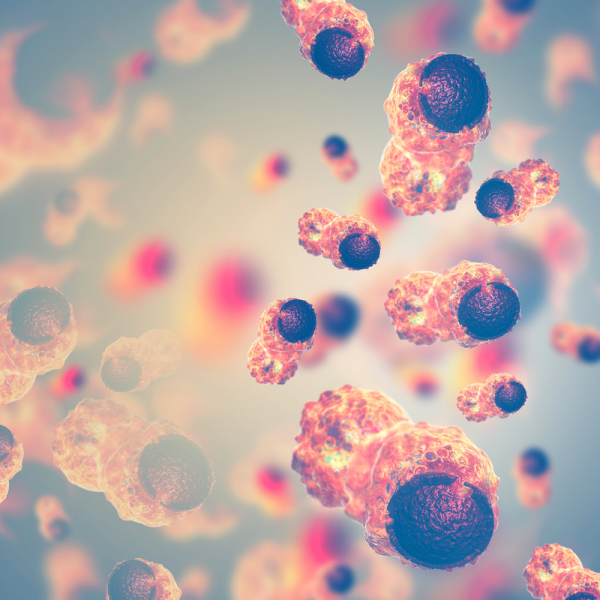
What is a chest wall tumour?
A tumour of the chest wall or thoracic tumour is called a thoracic wall tumour in technical language and describes a tumour that forms in the chest wall. The chest wall consists of different types of tissue. On the very outside is the skin and underneath it is the fatty and connective tissue. But the ribs, which consist of bone and cartilage tissue, also make up the chest wall. All these different types of tissue can form tumours, whereby the benign tumours appear as growths of normal tissue cells and the malignant tumours are degenerated tissue cells.
In about 9 percent of all cases, a tumour of the chest wall is malignant. Depending on the tissue of origin, the tumour bears the corresponding Latin or Greek name. For example, a malignant tumour of cartilage tissue is called chondrosarcoma, from the Latin name chondrocyte for cartilage cell. About 35 per cent of all tumours of the chest wall are benign. However, doctors also distinguish between so-called secondary tumours, which do not originate in the chest wall and have developed, for example, from a metastasis of kidney, thyroid, prostate or breast carcinomas (breast cancer) in the chest wall. They account for about 26 percent of all cases of the disease. But lung cancer (bronchial carcinoma) can also grow beyond the lungs and into the breast tissue. This type is also considered a secondary chest wall tumour.
What are the different types of chest wall tumours?
Doctors divide chest wall tumours into benign and malignant tumours as follows:
- benign tumours:
- Chondroma (arises in the cartilage),
- Fibroma (originates in connective tissue),
- Osteochondroma, fibrous dysplasia (arises in the bones),
- Haemangioma (arises in the vascular cells),
- Lipoma (arises in the fatty tissue),
- Nevus, also called mole (arises in the pigment cells),
- Neurofibroma (originates in the nerve connective tissue)
The most common benign tumours of the chest wall include osteochondroma, chondroma and fibrous dysplasia.
- malignant tumours:
- Angiosarcoma (arises in the vascular cells),
- Chondrosarcoma (originates in the cartilage),
- Fibrosarcoma (originates in connective tissue),
- Liposarcoma (arises in fatty tissue),
- Neurofibrosarcoma (originates in the nerve connective tissue),
- malignant melanoma (originates in pigment cells),
- Osteosarcoma, Ewing's sarcoma, solitary plasmocytoma (originates in the bones)
-
The most common malignant form of chest wall tumour is chondrosarcoma and fibrosarcoma.
What symptoms does a chest wall tumour cause?
A chest wall tumour usually only causes pain in the chest wall at an advanced stage. In addition, there may be an elevation or swelling in the chest wall area that can be felt. However, this is only possible if the tumour has reached a certain size. In rare cases, the area may become overheated and/or reddened. However, it is also possible that the chest wall tumour does not cause any symptoms and is diagnosed, for example, during a tumour screening or as a purely incidental finding.
How is a chest wall tumour diagnosed?
If a chest wall tumour is suspected, it can be clearly visualised and diagnosed with a computer tomography (CT) scan. Compared to conventional X-rays, a CT scan has the advantage that the tumour on the chest wall can already be precisely localised and also shows the lungs. This good imaging is mainly due to the fact that the CT shows a layered image in a cross-section of the body. Knowing the exact location and size of the tumour is essential for a possible operation. If necessary, an additional magnetic resonance imaging (MRI) can be carried out to clarify whether the tumour has already grown into neighbouring structures. This can affect the pleura, for example, but also the mammary gland.
How is a chest wall tumour treated?
The treatment of a chest wall tumour is always carried out in close cooperation with an oncologist, a thoracic surgeon and a plastic surgeon. As a rule, the first method of treatment is always to remove the chest wall tumour. Whether this is possible always depends on the type of tumour, its size and location. The surgical intervention can also be combined with other treatment methods such as radiotherapy or chemotherapy. In many cases, a chest wall replacement is necessary to restore stability, but also to protect the lungs. A chest wall replacement usually consists of a bone substitute, such as metal plates or plastic. However, it can also be made of a plastic mesh or bone cement.
Within one operation, a benign tumour is removed with a safety margin of 2 cm. For malignant tumours, the safety margin is between 4 and 5 cm. In concrete terms, this means that the doctor will always remove a few centimetres of healthy tissue around the tumour. This is to ensure that there are not still clusters of cells from which a new tumour can form. The actual surgical procedures differ depending on the tumour category and the neighbouring organs that may be affected. If it is a bone or cartilage tumour, for example, it is operated on according to the principles of compartment resection, i.e. if possible, the entire bone or cartilage is removed along with the surrounding connective tissue. However, the most common treatment method is the so-called partial chest wall resection, in which the lung tumour has spread to the adjacent chest wall tissue. If metastases have already appeared in the chest wall, these must also be removed.
What is the prognosis for chest wall tumours?
The prognosis of a chest wall tumour always depends on the type of tumour, its cell differentiation and the stage at which it is diagnosed. As with other cancers, the earlier a chest wall tumour is diagnosed and treated, the better its chances of cure. Primary chest wall sarcomas have an average 5-year survival rate of 17 per cent, with a much better prognosis if treated at an early stage.
